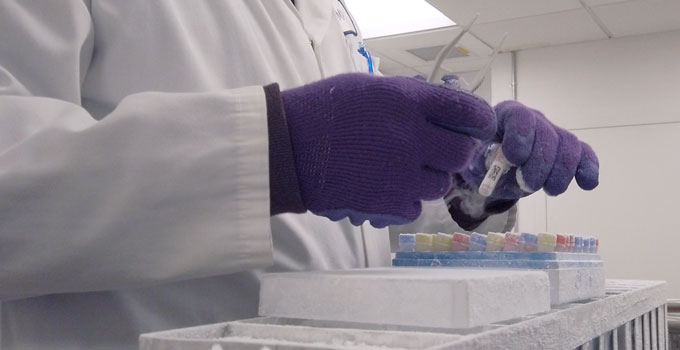
The Pan-Cancer project made international headlines this month, but not without the contributions of thousands of individuals and the teams that preserve their specimens
In an unprecedented, decade-long study of whole cancer genomes, OICR researchers and collaborators have improved our fundamental understanding of the disease, indicating new directions for developing diagnostics and treatments. The Project was powered by 2,800 people with cancer who donated their biologic specimens to research. These contributions were facilitated and protected by groups such as the Ontario Tumour Bank (OTB).
From the operating room to the freezer
Many advances in cancer research, like those made by the Pan-Cancer Project, rely on hundreds – and sometimes thousands – of biospecimens. A patient’s donated blood, tumour and surrounding tissue may hold clues to future innovations in cancer diagnostics and therapies. But without biobanks – the repositories that collect and care for biological samples – the clues within these donations may never be discovered.
“Good science is built on good data and good omics data can only be drawn from well-preserved tissues,” says Monique Albert. “The advancements made by the Pan-Cancer Project would not have been possible without the diligent work of biobanking teams.”
Albert is the Director of OTB – a provincial bioresource operating in partnership with four state-of-the-art hospitals and cancer centres across Ontario. OTB plays a quiet but crucial role between the patient and the researcher, providing the fundamental biologic resources that research is built on.
Lowering the temperature and raising the bar
Day-to-day, biobanking teams – like OTB – work to implement the highest standards of preservation. From the operating room to the freezer and back to the lab, these teams tirelessly strive to maintain the quality of patient samples to inform cancer discoveries. OTB has held and raised leading biobanking standards for over 15 years.
“When The Cancer Genome Atlas started, biobanks around the world promised thousands of samples, but only a fraction of these samples were adequate for research,” says Albert, referring to Libraries of Flesh: The Sorry State of Human Tissue Storage. “This served as a wake-up call for the sector to unite, share best practices and set higher standards together.”
At the launch of The Cancer Genome Atlas (TCGA) in the early 2000s, OTB was up to – and in many ways exceeded – existing biobanking standards. This was thanks to the foresight of Dr. Brent Zanke and Sugy Kodeeswaran, who recognized the importance of stringent biobanking practices nearly a decade before biobanking became popularized.
As the only Canadian repository that was able to contribute to TCGA, OTB allowed hundreds of people from Ontario to contribute to this international initiative and to subsequent studies like the Pan-Cancer Project.
Since its inception, OTB has collected more than 185,000 samples donated by more than 21,000 individuals from across Ontario, enabling these donations to have a greater impact today and for years to come.
“Each sample represents a trace of an individual’s life, and we’re honoured to care for these valuable donations to science,” says Albert. “When they’re preserved properly, they become a lasting resource with infinite value. We’re proud that the donations from Ontario patients are paving the way for better and more targeted cancer treatment.”
OTB plays a critical role in leading the development of Canadian biobanking standards through the Canadian Tissue Repository Network (CTRNet), and biobanking standards around the world through the International Society for Biological and Environmental Repositories (ISBER).
Read more about OTB’s research resources and how OTB is collaborating to improve biobanking around the world by visiting their website at ontariotumourbank.ca.
